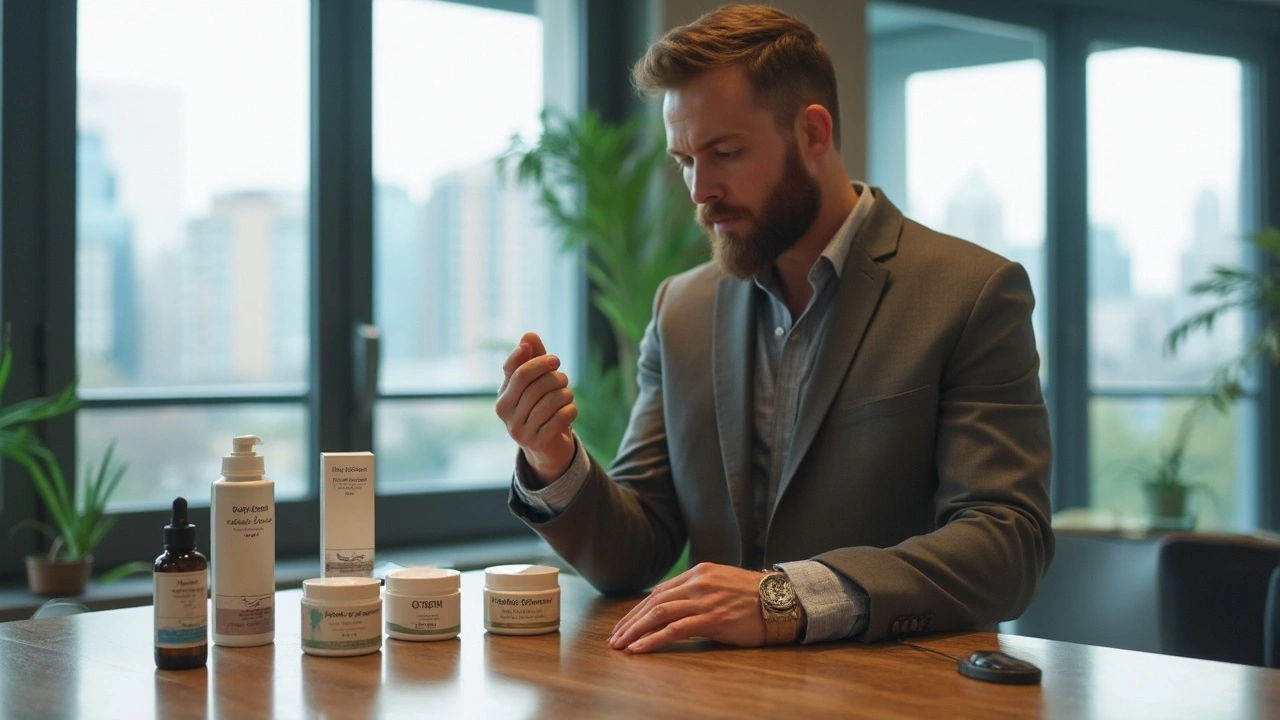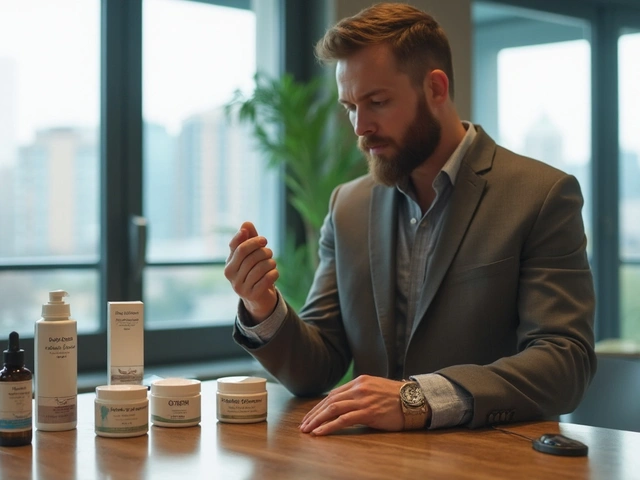
Thinking Propecia might not be the answer for your hairline? You’re definitely not alone. Plenty of guys either get tired of popping the daily pill, worry about side effects, or just want something different. But here’s the thing—hair loss doesn’t mean you’re stuck with only one choice.
There’s actually a whole lineup of alternatives, ranging from old-school surgery to at-home routines. Some options mean serious commitment (like going under the knife), while others just mean switching up what you put on your scalp or add to your supplement routine.
If you want the scoop on what’s available—what works, what costs more, and what might fit your lifestyle—you’re in the right spot. You’ll see both the upsides and drawbacks, plus real-world tips that go way beyond basic Google results. Ready to figure out which solution might actually help you keep that hair? Let’s break them down, one by one.
- Hair Transplant Surgery
- Minoxidil (Rogaine)
- Low-Level Laser Therapy (LLLT)
- Platelet-Rich Plasma (PRP) Therapy
- Dutasteride (Avodart)
- Natural Supplements
- Lifestyle Changes
- What Really Works? (Comparison Table)
Hair Transplant Surgery
If you’re looking for a fix that truly lasts and don’t mind taking the big leap, hair transplant surgery is about as permanent as it gets for hair loss solutions. Surgeons take healthy hair follicles—usually from the back or sides of your head—and move them to areas where your hair is thinning or gone. Forget wigs or hair fibers: this uses your real hair, and over 90% of transplanted follicles survive to grow in their new spot.
There are a couple main techniques: FUE (follicular unit extraction) and FUT (follicular unit transplantation, also called the "strip method"). FUE is super popular now because it’s less invasive, leaves minimal scarring, and lets you wear your hair shorter. With FUT, you might recover a little faster and get more grafts in one shot, but you’ll have a thin scar where they took the strip.
The upside? The results look incredibly natural if you work with a solid clinic. Once that new hair takes, you treat it just like your regular hair—cut, style, whatever. The catch? This is easily the priciest Propecia alternative out there, with most guys shelling out anywhere from $3,000 up to $15,000 per session. And yeah, sometimes you’ll need more than one session for full coverage.
You’ll also need about a week to 10 days of downtime, depending on which technique you choose. Don’t plan to hit the gym or go swimming the next day—your head will be healing, and protecting those new grafts is a must. Full results can take up to a year to show, but you’ll notice growth kicking in around month four to six.
Pros
- Natural-looking, permanent results
- High success rate (90%+ graft survival)
- No ongoing maintenance—one and done for most people
Cons
- Really expensive ($3,000–$15,000 per procedure)
- Requires anesthesia and a trip to a surgical clinic
- Recovery takes 7–10 days
- Possible scarring at donor sites
- Doesn’t prevent future hair loss—more sessions may be needed later
| Feature | Details |
|---|---|
| Cost | $3,000–$15,000 per session |
| Success Rate | Over 90% graft survival |
| Recovery Time | 7–10 days |
| Best Suited For | Men with stable hair loss & enough donor hair |
If you’re sick of pills like Propecia and want a real shot at regrowing your hair, this is the gold standard—but it’s not for the faint of wallet (or scalp).
Minoxidil (Rogaine)
If you’re not ready for surgery but want to do something about thinning hair, Minoxidil (the stuff in Rogaine) is probably the easiest place to start. This over-the-counter topical treatment was first used for high blood pressure, but researchers noticed a surprising side effect: People started growing more hair. Now, it’s one of the big names in hair loss solutions for both men and women.
Minoxidil comes as a foam or liquid, and you just rub it into your scalp once or twice a day. It works by widening blood vessels around the hair follicles, giving them more oxygen and nutrients. That can lead to thicker, stronger hair and sometimes—if you’re lucky—a bit of regrowth.
But here’s the important bit: Minoxidil isn’t a miracle fix. You won’t wake up with a full head of hair after a few uses. It usually takes three to six months to see results, and even then, regrowth is mostly seen around the crown, not the hairline. And if you stop using it, whatever gains you made will probably start disappearing within a few months.
Minoxidil becomes almost like brushing your teeth: skip it for a week, and things go downhill.
Pros
- Available without a prescription
- Affordable (usually $20–$40/month)
- Backed by plenty of solid research
- Can slow hair loss and promote regrowth for many men
- Works well for both early and moderate hair loss
Cons
- Needs daily use—forever—to maintain results
- Messy, can leave hair feeling greasy or sticky
- Common side effects: scalp irritation, dryness, sometimes itching or flakes
- Best for the crown (not the temples/hairline)
- Stopping means losing whatever new hair you gained
If you’re the data-driven type, check out this quick table pulled from FDA studies and real-world results:
| Result (Men's 5% Minoxidil) | After 4 Months | After 12 Months |
|---|---|---|
| Some regrowth | ~40% | ~60% |
| No improvement | ~60% | ~40% |
Bottom line: Minoxidil is a solid pick if you want something proven, easy to buy, and don’t mind adding one more step to your daily routine. But you do need to keep using it as long as you care about hair loss.
Low-Level Laser Therapy (LLLT)
Ever seen those glowing laser helmets or combs on social media ads? That’s Low-Level Laser Therapy, or LLLT for short. It’s a non-invasive way to tackle hair loss and is showing up everywhere as a Propecia alternative. The idea behind LLLT is simple: certain wavelengths of light (usually red) stimulate your hair follicles, helping them wake up and grow stronger hair. No drugs, no surgery, and you can do it at home or in a clinic.
What’s cool about LLLT is that you don’t need a prescription. Most guys pick up a laser cap or comb, toss it on a few times a week for 15-30 minutes, and that’s it. There are hundreds of brands out there, but all work on the same science—boosting blood flow and cellular activity around thinning hair.
It’s not instant magic though. Results can take three to six months, and the best results show up for men dealing with mild to moderate thinning—not total baldness. If you check the research, a 2017 review in "Lasers in Surgery and Medicine" found that LLLT devices led to significant increases in hair count for users after 16-26 weeks. But, as with everything, you have to stick with it, or your results fade away pretty quickly.
Pros
- Non-invasive and pain-free—no needles, no scalpels
- You can do it at home or in a clinic
- No known serious side effects so far
- Works for both men and women
- Easy to pair with other hair loss solutions like minoxidil
Cons
- Caps and combs cost anywhere from $200 to $2,000 upfront
- You need to use it regularly (2-4 times a week)
- Won’t work well for totally bald areas, only for thinning hair
- Results take several months—patience required
- If you stop using it, hair loss may return
| Treatment Time | 15-30 minutes/session |
|---|---|
| Frequency | 2-4 times/week |
| Best for | Mild-Moderate Hair Loss |
| Works for | Men and Women |
| Side Effects | Minimal to None |
If you want something you can do at home without popping pills, LLLT is worth considering. Just make sure you’re ready to commit for a few months, and maybe combine it with other hair loss solutions for even better results.
Platelet-Rich Plasma (PRP) Therapy
Platelet-Rich Plasma (PRP) therapy is making waves as a Propecia alternative, and it’s definitely not just hype from influencers. This treatment basically uses your own blood to boost hair growth. It sounds strange, but here’s the process: a specialist draws a small sample of your blood, spins it in a centrifuge to separate out the PRP, then injects that super-concentrated plasma into thinning spots on your scalp.
The logic is pretty straightforward. The platelets in your blood are packed with growth factors. When injected, these growth factors supposedly jumpstart inactive or weak hair follicles. The whole session takes about an hour, and you walk out the same day with just a sore scalp.
One legit study from 2021 in the Journal of Cutaneous and Aesthetic Surgery found that after three monthly PRP sessions, about 70% of patients noticed visible new hair growth.
“PRP is a safe, natural option for men who aren’t seeing results from topical or oral hair loss solutions. It doesn't require any daily maintenance—you just come in for an occasional booster session.” — Dr. Maria Robinson, dermatologist
The procedure isn’t a miracle, though. It costs between $1,000 and $3,000 for the first three treatments, and you’ll likely need a maintenance shot every 6-12 months. It also hurts a little—the needles aren’t tiny.
Pros
- Uses your own blood, so no drugs or chemicals
- No major downtime—go back to work the same day
- Natural-looking thicker hair
- Can be combined with other hair loss solutions
Cons
- Expensive (costs add up over time)
- Results aren’t instant—takes months to see real growth
- Not guaranteed for everyone (works better for recent hair loss)
- Scalp can be sore or bruised after each session
Here’s a quick look at typical PRP results:
| PRP Sessions | Average Improvement |
|---|---|
| After 3 sessions | 20-30% thicker hair in treated areas |
| 6 months post-treatment | 40-50% of patients keep new growth with maintenance |
If you’re avoiding pills and want a hair loss solution right off the doctor’s shelf, PRP gives you a natural (but not painless) shot at regrowth.

Dutasteride (Avodart)
If you’re looking for something even stronger than Propecia, Dutasteride—sold as Avodart—is one of the top contenders. It’s actually a prescription drug originally made for treating enlarged prostates, but a lot of guys and doctors noticed it can work overtime for blocking hair loss. The cool thing? Dutasteride blocks both types of the enzyme (5-alpha reductase) that turn testosterone into DHT, while Propecia only blocks one. Since DHT is basically the main villain behind male pattern baldness, it’s easy to see why this option gets so much attention.
What about real-world results? In several studies, Dutasteride came out stronger than Propecia (finasteride) for stopping hair shedding and even helping with regrowth. One study from South Korea showed that men on 0.5mg of Dutasteride had better hair count numbers and thicker hair after 24 weeks compared to those on Propecia. Not bad, right?
| Medication | Targeted Enzyme Types | Hair Regrowth (6-month study) |
|---|---|---|
| Propecia (Finasteride) | Type 2 | ~30% |
| Avodart (Dutasteride) | Types 1 & 2 | ~40-45% |
But there’s a catch. The same turbo-charged DHT blocking that boosts its hair loss solutions powers can also mean more risk for side effects, like reduced libido, trouble with erections, or mood changes. Doctors usually reserve Dutasteride for men who just aren’t seeing results on Propecia, or who need the heavy artillery. It’s not FDA-approved in the US for hair loss, but it’s popular in places like South Korea and Japan, and you can sometimes get it prescribed “off-label” by hair specialists in the States.
Pros
- Stronger than Propecia for blocking hair loss
- Works for men who didn’t get results from finasteride
- Can help get back some regrowth in stubborn areas
Cons
- Higher chances of sexual side effects
- Not FDA-approved for hair loss in the US
- Needs a doctor’s prescription and regular checkups
- More expensive than generic finasteride
Natural Supplements
If you’re not too keen on prescriptions or surgery, natural supplements might sound like the friendlier route for tackling hair loss. Plenty of guys hit up health stores looking for a magic fix, but here’s where things get real—some supplements show potential, but none are miracle workers.
Probably the best-known options are saw palmetto, biotin, pumpkin seed oil, and zinc. Saw palmetto gets talked up a lot because it’s thought to block DHT—a hormone that’s a big factor in male pattern baldness. There are a couple of small studies showing saw palmetto can slow down hair loss, especially for guys in early stages. But results aren’t as dramatic as with Propecia or even minoxidil.
Biotin is everywhere in hair gummies and vitamins, but unless you’re actually low in biotin, loading up on it won’t do much. You’ll see it listed in tons of "hair growth" blends because it’s safe, but don’t expect miracles—most men aren’t deficient. Keeping an eye on your general nutrition is way more important. If you want to cover your bases, a daily multivitamin with B vitamins and zinc is a safe bet.
- Pumpkin seed oil comes up in newer studies, with some showing it could help a bit with hair growth after several months—again, nothing mind-blowing, but worth a try if you like to keep things natural.
- Marine collagen and certain amino acids also claim to help with hair health, but research is still early. You’re probably better off just eating a protein-rich diet.
- Remember: supplements can interact with medications or health conditions. Always check with your doctor before diving in, even for "natural" stuff.
| Supplement | Possible Effect | Evidence Strength |
|---|---|---|
| Saw Palmetto | Might block DHT, slow hair loss | Low to Moderate |
| Biotin | Supports healthy hair if deficient | Low (unless you have deficiency) |
| Pumpkin Seed Oil | May boost hair growth slightly | Low to Moderate |
| Zinc | Supports hair health | Low (unless deficient) |
Bottom line: natural supplements are low-risk for most people, but don’t expect results anywhere near what you’ll get from prescription drugs or medical procedures. If you go this route, stick to reputable brands and make sure your overall health is on point—it’s not just about one vitamin or herb. And always remember, if you suddenly lose a bunch of hair, it’s smart to rule out underlying issues that supplements can’t fix.
Lifestyle Changes
This option doesn’t ask you to shell out cash for pricey surgery or commit to a pharmacy routine, but that doesn’t mean it’s just wishful thinking. Your daily choices have way more impact on hair loss solutions than most people realize. While you can’t fight genetics, you can fight back against hair loss made worse by lifestyle.
The first big hitter: stress. Chronic stress messes with your hormones and can push your hair into a resting phase (doctors call it telogen effluvium). That means less hair growth and more shedding. Things like getting decent sleep, meditation, or just blocking out time for yourself actually help keep your hair where it belongs.
Diet isn’t just for gym buffs—your hair needs nutrients too. Iron, vitamin D, and protein are vital. Low iron or protein can mean weak hair or, for some, hair falling out in clumps. Quick tip: eggs, lean meat, spinach, and nuts are simple adds to your routine that really help. If you’re vegan or vegetarian, don’t skip the supplements—iron and B12 need backup.
Over-styling and rough treatment can sabotage the best Propecia alternatives. Hot tools, chemical dyes, and tight ponytails literally pull hair from the root or damage the shaft, making thinning worse. Switching to loose styles, air-drying, and less-frequent coloring goes a long way. Gentle, sulfate-free shampoos also protect your scalp.
For a lot of guys, smoking and heavy drinking are part of the problem. Both mess with blood flow and nutrition, making it tough for follicles to thrive. Limiting alcohol and cutting out tobacco make a visible difference within months.
There’s some pretty solid research behind these points. For example, a 2018 survey of over 500 men found those with healthier lifestyles—less stress, good diet, more sleep—reported less hair loss on average. Researchers found healthy habits didn’t replace advanced hair loss treatments, but they did help protect what you already have.
- Prioritize sleep (aim for at least 7 hours)
- Get regular exercise to boost circulation
- Eat a balanced diet with enough iron and protein
- Curb smoking and limit alcohol
- Be gentle with your hair (skip the daily heat)
- Find ways to manage stress regularly
These adjustments might sound basic, but when you’re trying to make a change without side effects or big expenses, lifestyle tweaks can be surprisingly powerful. You won’t wake up with a new hairline, but you just might hold onto what you’ve got longer.
What Really Works? (Comparison Table)
When you line up all the Propecia alternatives, it gets way easier to see how they stack up. Not every solution makes sense for everyone—maybe you care about price, maybe you want zero downtime, or maybe you’re just after whatever’s easiest to stick with. Here’s a straight-up side-by-side table that compares the core options, how they’re used, their success rates, and a ballpark on cost:
| Alternative | How It Works | Effectiveness | Cost Range | Maintenance | Downtime | Side Effects |
|---|---|---|---|---|---|---|
| Hair Transplant Surgery | Moves your own hair follicles to bald spots | 85–95% see clear, lasting regrowth | $3,000–$15,000+ | None after healing | About 1 week | Scarring, pain, rare infection |
| Minoxidil (Rogaine) | Topical foam or liquid increases blood flow to scalp | 60–70% notice slowing loss or regrowth | $30–$50/month | Daily, ongoing | None | Itchy scalp, mild irritation |
| Low-Level Laser Therapy (LLLT) | Light devices stimulate follicles | About half see visible improvements | $200–$1,200 | 3-4 times/week | None | No major side effects |
| Platelet-Rich Plasma (PRP) | Injections of your blood’s plasma encourage new growth | Up to 70% see density boost | $400–$2,500/session | Touch-ups every 6–12 months | Usually none | Tenderness, swelling |
| Dutasteride (Avodart) | Oral medication, blocks even more DHT than Propecia | Similar or slightly higher than Propecia | $75–$200/month | Daily | None | Libido changes, rare breast tenderness |
| Natural Supplements | Pills or oils (saw palmetto, pumpkin seed) | Mixed & less proven | $10–$60/month | Daily | None | Usually mild stomach issues |
| Lifestyle Changes | Diet, lowering stress, smart grooming | Helps delay, not regrow much | Low to free | Constant | None | None |
So, which alternatives truly give hair loss solutions that last? If you want permanent results and don’t mind the price tag, hair transplant surgery is the only method rated by dermatologists as a real fix—not just a “maybe.” But, if downtime and surgery aren’t your thing, daily options like Minoxidil or even laser therapy work for lots of guys, provided you can stick to the routine. PRP delivers the most impressive results outside of surgery, but it costs a chunk and needs follow-ups.
Here’s a quick reality check: There’s no magic fix. Stopping Propecia comes down to what you’re willing to try next. Most men use a combo approach instead of relying on one single tool. A bit of science, a bit of patience, and a solid routine—that’s your best bet for outsmarting hair loss.







The cost of a hair transplant can easily exceed $5,000, making it unsuitable for budget‑constrained individuals :)
omg i tried the minoxiDIL thing and my scalp felt like a desert, ugh! i was sooo hopeful at first, but then the irritation hit hard. like, why does a simple foam turn my head into a snowstorm of flakes? i guess that's the drama of trying to avoid the big $$$ surgery, lol. somehow i still feel like i wasted a month of my life on sticky scalp.
Look, the article pretends a $5k transplant is "reasonable" for the average american, which is outright false. You can't just tell people to throw away their hard earned cash without mentioning the real financial strain. Most folks can't afford that, yet you act like it's a normal option. Stop glorifying pricey procedures and start giving realistic advice.
First of all, congratulations on gathering such an exhaustive list of hair‑loss alternatives; the effort is evident, and that deserves a round of applause!; However, let’s dive deeper into the practical side of each option-cost, commitment, and realistic expectations are paramount; While hair‑transplant surgery offers permanent results, the price tag can be prohibitive for many, and the recovery period can disrupt weekly routines; Minoxidil, on the other hand, is affordable and widely available, but it requires unwavering daily application, which can feel like an endless chore; Low‑Level Laser Therapy devices are a middle ground-up‑front cost is significant, yet there are no ongoing prescription fees, but the efficacy varies widely between brands; PRP therapy stands out for its natural approach using the patient’s own blood, yet multiple sessions are needed and the cumulative cost can rival that of a modest transplant; Dutasteride may outperform finasteride in blocking DHT, but the risk of sexual side effects makes it a decision best made with a physician; Natural supplements such as saw palmetto and pumpkin seed oil are low‑risk, but their impact is modest at best and should be paired with a solid nutritional foundation; Lifestyle changes-stress management, balanced diet, and gentle hair care-are free and beneficial, yet they merely slow progression rather than restore lost hair; In the end, a combination of methods often yields the best outcome, because no single solution addresses every facet of hair‑loss; So, weigh your budget, tolerance for maintenance, and desired results before committing to any single path; Remember, consistency is the hidden hero in any regimen, whether topical, oral, or procedural; Lastly, consult a qualified dermatologist to tailor a plan that fits your unique situation, because personalized advice trumps generic tables every time.
Building on the thorough overview above, it helps to think of hair‑loss treatment as a layered strategy rather than a single silver bullet; Combining minoxidil with occasional low‑level laser sessions can boost follicle activity while keeping daily effort manageable; Adding a high‑quality multivitamin that covers biotin, zinc, and vitamin D fills nutritional gaps that may otherwise limit growth; If the budget allows, a single PRP session can jump‑start results, and the maintenance schedule can be tuned to your response; Lifestyle tweaks-adequate sleep, regular exercise, and stress‑relief practices-create a supportive environment for any treatment to thrive; Ultimately, the key is to set realistic milestones and track progress over months, not weeks.
Oh great, another “comprehensive guide” that reads like a shopping catalog for baldness; As if we needed a seventeen‑item checklist to decide how to waste more money on our heads; The tone suggests that if you can’t afford a transplant you should settle for a laser hat that probably doubles as a night‑light; And of course, the comparison table pretends all options are equally viable, ignoring the fact that most of them barely out‑perform a placebo; But hey, at least the author managed to cram every possible buzzword into a single article-kudos for sheer verbosity.
While the previous comment highlights the frustration many feel, it’s worth emphasizing concrete steps that truly help; Start with a thorough scalp assessment by a dermatologist to identify the most appropriate primary treatment; For those opting for topical solutions, ensure proper application-clean, dry scalp, letting the product absorb fully before styling; If considering systemic options like dutasteride, discuss potential side effects and required lab monitoring with your doctor; Finally, keep a simple log of any changes-hair density, shedding rate, and side effects-to objectively evaluate progress over time.